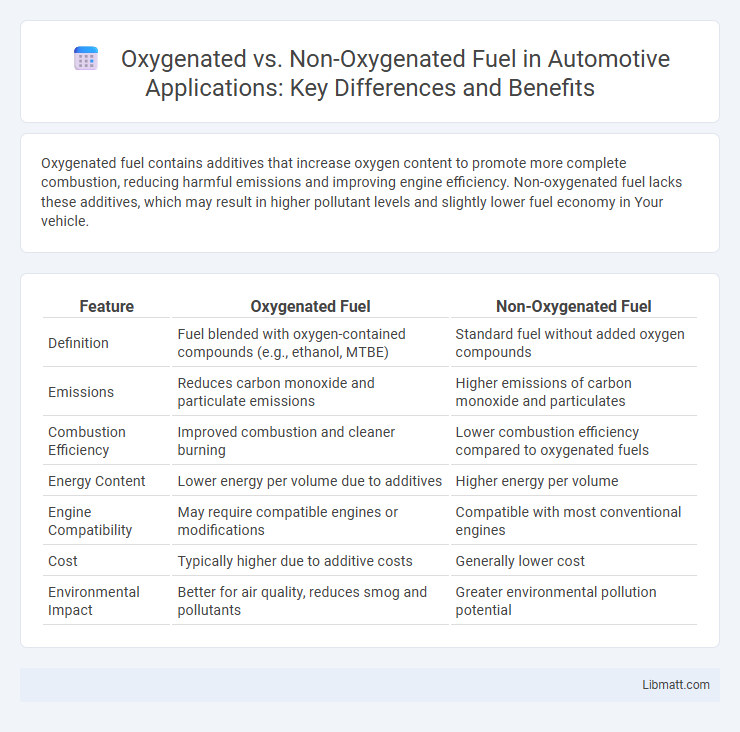Oxygenated fuel contains additives that increase oxygen content to promote more complete combustion, reducing harmful emissions and improving engine efficiency. Non-oxygenated fuel lacks these additives, which may result in higher pollutant levels and slightly lower fuel economy in Your vehicle.
Table of Comparison
| Feature | Oxygenated Fuel | Non-Oxygenated Fuel |
|---|---|---|
| Definition | Fuel blended with oxygen-contained compounds (e.g., ethanol, MTBE) | Standard fuel without added oxygen compounds |
| Emissions | Reduces carbon monoxide and particulate emissions | Higher emissions of carbon monoxide and particulates |
| Combustion Efficiency | Improved combustion and cleaner burning | Lower combustion efficiency compared to oxygenated fuels |
| Energy Content | Lower energy per volume due to additives | Higher energy per volume |
| Engine Compatibility | May require compatible engines or modifications | Compatible with most conventional engines |
| Cost | Typically higher due to additive costs | Generally lower cost |
| Environmental Impact | Better for air quality, reduces smog and pollutants | Greater environmental pollution potential |
Introduction to Oxygenated and Non-Oxygenated Fuels
Oxygenated fuels contain compounds like ethanol or MTBE that introduce oxygen into the combustion process, improving fuel efficiency and reducing carbon monoxide emissions. Non-oxygenated fuels lack these additives, often resulting in higher pollutant outputs but offering greater energy density and engine compatibility. The choice between oxygenated and non-oxygenated fuels impacts environmental regulations, engine performance, and overall air quality.
Chemical Composition Differences
Oxygenated fuels contain compounds like ethanol or MTBE that incorporate oxygen atoms into their molecular structure, enhancing combustion efficiency and reducing emissions. Non-oxygenated fuels lack these oxygen-containing additives, consisting primarily of hydrocarbons such as alkanes, cycloalkanes, and aromatics. Your choice between these fuels influences the chemical reactions within the engine and the resulting environmental impact.
How Oxygenated Fuels Work
Oxygenated fuels contain compounds like ethanol or methanol that introduce extra oxygen into the combustion process, promoting more complete fuel burning and reducing harmful emissions such as carbon monoxide. These fuels enhance engine efficiency and contribute to cleaner exhaust by improving the oxidation of carbon-based pollutants. Using oxygenated fuels in your vehicle can lead to better air quality while maintaining performance.
Advantages of Oxygenated Fuels
Oxygenated fuels improve combustion efficiency by increasing the oxygen content in the fuel mixture, which reduces carbon monoxide (CO) and particulate emissions significantly. They enhance engine performance by promoting cleaner burning and reducing engine deposits, contributing to better fuel economy and lower maintenance costs. These fuels also help meet stringent environmental regulations by decreasing the release of harmful pollutants, supporting cleaner air quality.
Drawbacks of Oxygenated Fuels
Oxygenated fuels often lead to lower energy density compared to non-oxygenated fuels, resulting in reduced fuel economy and increased fuel consumption. These fuels can cause material compatibility issues, such as corrosion in engine components and fuel systems, increasing maintenance costs. Furthermore, oxygenated fuels may contribute to higher emissions of certain pollutants like formaldehyde and acetaldehyde, posing environmental and health concerns.
Benefits of Non-Oxygenated Fuels
Non-oxygenated fuels offer higher energy content per gallon, resulting in improved fuel efficiency and longer engine runtime compared to oxygenated fuels. These fuels produce fewer corrosive byproducts, which helps maintain engine durability and reduces maintenance costs for your vehicle. Using non-oxygenated fuel can also lead to more consistent combustion and better performance in engines not designed for oxygenated blends.
Disadvantages of Non-Oxygenated Fuels
Non-oxygenated fuels tend to produce higher emissions of carbon monoxide and unburned hydrocarbons due to incomplete combustion. They contribute significantly to air pollution and smog formation, impacting public health and environmental quality. The lack of oxygenates also results in poorer engine performance and increased fuel consumption compared to oxygenated fuels.
Environmental Impact Comparison
Oxygenated fuel reduces carbon monoxide emissions by promoting more complete combustion, leading to lower air pollution and improved air quality compared to non-oxygenated fuel. Non-oxygenated fuel tends to produce higher levels of harmful pollutants such as hydrocarbons and particulate matter, contributing to smog formation and health risks. Using oxygenated fuel supports Your efforts to minimize environmental impact and comply with stricter emission regulations.
Performance: Engine Efficiency and Power Output
Oxygenated fuel enhances engine efficiency by promoting more complete combustion, resulting in higher power output and reduced emissions compared to non-oxygenated fuel. The additional oxygen content in oxygenated fuels improves fuel burn rate, leading to smoother engine operation and increased thermal efficiency. Non-oxygenated fuels often produce more carbon deposits and incomplete combustion, which can reduce engine performance and longevity over time.
Choosing the Right Fuel for Your Vehicle
Oxygenated fuel contains compounds like ethanol or MTBE that enhance combustion efficiency, reduce harmful emissions, and improve engine performance, making it a preferred choice for eco-conscious drivers. Non-oxygenated fuel, often pure gasoline, offers straightforward energy output but may contribute to higher emissions and less efficient burning. Choosing the right fuel for your vehicle depends on manufacturer recommendations and environmental considerations to ensure optimal engine health and compliance with emissions standards.
Oxygenated fuel vs Non-oxygenated fuel Infographic

 libmatt.com
libmatt.com